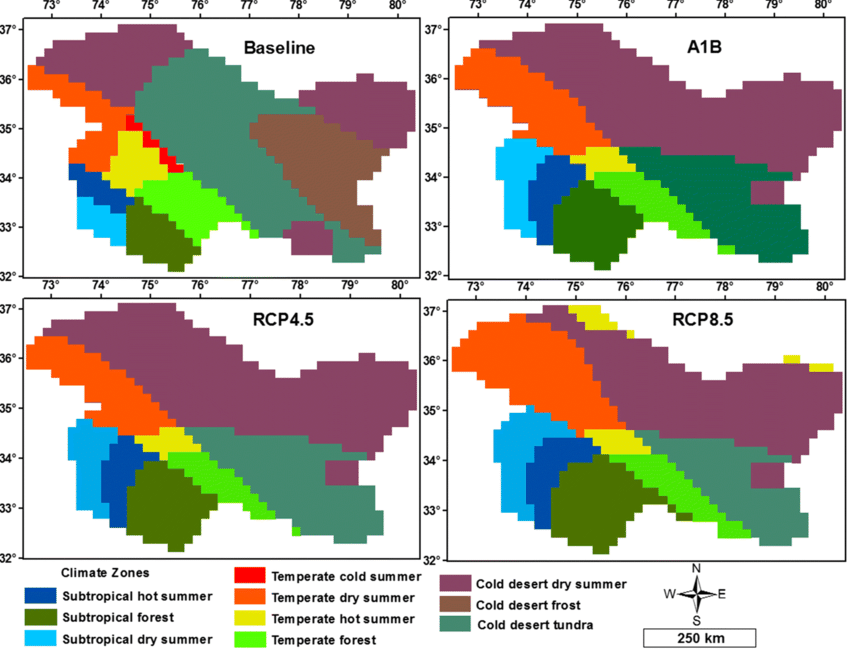Climate change and global warming have recently become an important topic of concern and discussion among the scientific community, policymakers, media and in general public for its far-reaching impacts on various sectors of economy, livelihoods and ecosystems. The concentrations of greenhouse gases such as carbon dioxide and other gases has been increasing significantly since the last few decades and is largely responsible for global warming. The evidence for global climate change is now well established beyond any doubt based on the plethora of scientific research on the subject, mainly collated by the Inter-governmental Panel on Climate Change (IPCC) in the form of Assessment Reports.
Kashmir, a picturesque region located in the northern part of the Indian subcontinent, is experiencing the impacts of climate change like many other regions around the world. The Himalayan region, including Kashmir valley, is particularly vulnerable due to its unique geographical and ecological characteristics. The region referred to as “Paradise on Earth” is at the crossroads of a major environmental crisis if preventive and remedial measures are not taken at the right earnest. Like rest of the world, the temperatures in Jammu, Kashmir and Ladakh Himalaya, are rising at significantly increasing rates. Contrary, the precipitation overall does not show any significant change over the region, but the form of winter precipitation has changed from snow to rain during the last few decades.
We are now getting rains even during the harshest part of our winter- Chilai Kalan. The situation may further exacerbate under the projected climate change reducing the snow precipitation significantly in the future. Furthermore, the climate extremities have increased manifold from past few decades due to the impacts of climate change. The rising temperatures together with the changes in the existing precipitation regime is posing a serious threat to the many sectors of our economy because of their dependence on water availability, vegetation distribution, and glacier systems. The projected changes are predicted to affect several key sectors of our economy such as agriculture, horticulture, hydropower generation, irrigation and even tourism. We recently experienced the adverse impact of dry spell on winter tourism in Gulmarg. Although, we don’t have a direct control over climate, which is driven largely by atmospheric circulation and solar activity however minimizing the anthropogenic contribution to climate change through proper adaptation, and mitigation measures can reduce the human and economic consequences of the impending climate change in the world.
The drivers of the anthropogenic climate change are primarily the increasing emissions of greenhouse gases in the atmosphere and other pollutants. Greenhouse gas emission is directly related to fossil fuel use, industrialisation, deforestation, air pollution, and other environmental unfriendly activities across the globe. Though, the mountainous regions like Jammu, Kashmir and Ladakh are the least industrialised, unfortunately, we are bearing the brunt of the climate change for no fault of overs as the phenomena has global dimensions and footprint.
Our several studies on climate change and its impacts on various sectors of economy, that has been published in reputed international journals, have projected that the average annual temperature to increase will by 5.2 degrees Celsius, 4.8 degrees Celsius, and 6.5 degrees Celsius by the end of the twenty first century in Kashmir, Jammu and Ladakh regions, respectively under the worst scenario of climate change, namely RCP8.5. If the current emission rates of greenhouse gases are not reduced in future, the global average temperature is likely to rise by nearly 5 degrees Celsius by the end of the twenty-first century under the worst climate change scenario. There will be significant impacts on almost every sector of economy in Jammu, Kashmir and Ladakh due to the climate change driven temperature increase.
As per our studies, glaciers, the most important resource of in the region, are going to shrink by around 85 per cent by the end of the century under the worst climate change scenario, if, the projections come true. This would lead to significant depletion of the stream flows in the major rivers of Jammu and Kashmir, the waters of which are shared between neighbouring countries in the South Asia. Similarly, the impacts on agriculture, horticulture and even tourism shall significantly threaten the livelihood of the dependent population in the region.
In several of our published research works, we have predicted that the impact of future climate change over Jammu, Kashmir and Ladakh Himalaya, by the end of the twenty-first century based on an ensemble of 11 climate models under three greenhouse gas emission scenarios. The studies have a highlighted the changes in the distribution of the prevalent climate zones in the region. The projected climate change under the three emission scenarios also indicates significant changes in the distribution of prevalent climate zones.
The projected climate change under different scenarios revealed that the subtropical and temperate climatic zones in Jammu and Kashmir respectively would expand while the cold desert climate zone in the Ladakh region is projected to shrink significantly under all the three climate change scenarios. The cold desert climate zone in the Ladakh region would shrink by 22% and the subtropical and temperate zones would expand by 13% and 9% respectively due to the projected climate change.
The projected changes in the climate and climate zones by the end of the twenty-first century would have significant impacts on various sectors in the region which might lead to the redistribution and changes in the composition of vegetation, depletion of river flows, increase in the frequency of dry spells, loss of wetlands, increasing glacier recession, etc.
The situation would also lead to an increase in the frequency of climate extremes, changes in the faunal and floral biodiversity, plant invasions, and changes in agriculture and horticulture productivity. This will adversely impact water security, food security and energy security in the region with adverse impacts on several key economic sectors in the region. It is therefore essential that we have in place actionable climate changes adaptation and mitigation plans at village level to minimize the adverse impacts of the impending climate change on our livelihoods, economy and ecosystem services.
(Author is Postdoctoral Fellow, Centre of Excellence for Glacial Studies, University of Kashmir, Hazratbal, Srinagar)








